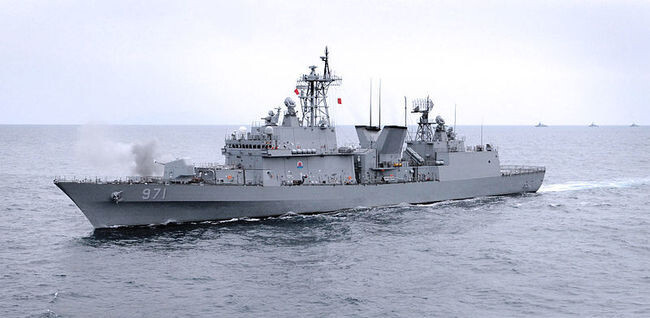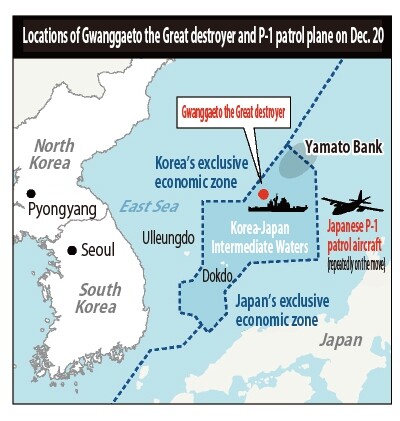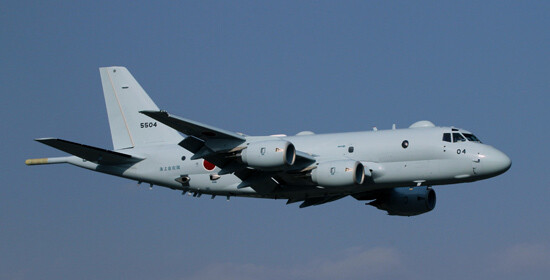hankyoreh
Links to other country sites 다른 나라 사이트 링크
S. Korean naval vessel’s targeting radar locking onto Japanese plane turns into diplomatic issue


The appearance of a Japanese patrol aircraft within radar tracking range during a South Korean naval vessel’s rescue of a North Korean ship is turning into a diplomatic issue as Japan continues taking issue with a South Korean naval vessel locking its targeting radar on a Japanese patrol aircraft.
The response from Tokyo is being viewed by Seoul as “deliberately excessive.”
The Jiji Press news agency reported that Kenji Kanasugi, director-general of the Japanese Foreign Ministry's Asian and Oceanian Affairs Bureau, planned to raise a related protest on Dec. 24 at a bilateral meeting of foreign affairs officials at the bureau director level in Seoul.
“I would also like to communicate about that [radar issue],” Kanasugi announced at the time of his Dec. 23 departure.

On the afternoon of Dec. 20, a Japanese P-1 patrol aircraft appeared on the targeting radar of the South Korean Gwanggaeto the Great destroyer conducting a search after being notified that a North Korean fishing boat was adrift in international waters 100km northeast of Dokdo.
In an emergency press conference on the afternoon of Dec. 21, Japanese Minister of Defense Takeshi Iwaya protested the use of targeting radar, calling it “exceedingly dangerous” and referring to the “gravity of the situation.” Iwaya also said the use of targeting radar “represents the stage before the actual use of weaponry.”
The South Korean military countered that it was merely using all of its radar capabilities for the
rescue effort. The navy reportedly located a drifting North Korean vessel and rescued its crew, with one dead body recovered.
But in a release on Dec. 22, the Japanese Ministry of National Defense insisted, “Targeting radar is used to measure the precise direction and distance of an attack target. It is not suited for a wide-range search, and the use of maritime search radar would be more appropriate for the rescue of a wrecked vessel.”
Speaking on condition of anonymity, a Japanese Self-Defense Forces official told the Yomiuri Shimbun newspaper, “If it were the US military in a state of emergency, they would have attacked.”
Responding to the repeated statements from Japan, a South Korean Navy official said, “We sometimes conduct searches with targeting [radar] in emergency situations or when weather conditions are poor.”
“Our destroyer had its radar operating continuously for search purposes, regardless of the Japanese patrol aircraft,” the official explained.
The official also disputed the Japanese Defense Ministry’s claims that the targeting radar was aimed at the patrol aircraft. According to the official, only the fire-control system’s three-dimensional MW08 radar for wide-range searches was in operation, while its signal tracking and illumination radar (STIR) – in which a beam is fired toward a target to calculate the distance for a strike – was not used.
The reason the Japanese side continues raising issues with the incident – even after the South Korean military explained that the aircraft was not deliberately targeted and that the North Korean fishing boat was indeed rescued – appears to stem from the recent state of relations between the two sides. In particular, it suggests an attempt by Tokyo to use the “radar incident” for leverage amid its protests over a recent South Korean Supreme Court decision on compensation for forced labor. The first bilateral meeting of bureau director-level foreign affairs officials since the ruling was scheduled to take place on Dec. 24.
“This also looks like an attempt to intimidate the South Korean military into restricting its activities,” a South Korean Navy official said.
In related news, on Dec. 20 the Gwanggaeto the Great destroyer discovered the small North Korean fishing boat that had been drifting for several weeks, rescuing three North Korean crew members and recovering the body of one deceased. The South Korean government announced that the rescued North Korean nationals and recovered body had been repatriated to the North via Panmunjom on Dec. 22.
In Japan as well, former Japan Air Self-Defense Force Chief of Staff Toshio Tamogami took to Twitter to explain, “Since firing a missile would entail simultaneously overriding safeguards in multiple sections within the warship, the mere fact that targeting radar waves were intercepted does not indicate an immediate risk.”
“This sort of thing is something armed forces around the world do on a daily basis,” he argued, suggesting that Japan was being excessive with its response.
By Cho Ki-weon, Tokyo correspondent, and Noh Ji-won, staff reporter
Please direct comments or questions to [english@hani.co.kr]

Editorial・opinion
![[Editorial] Does Yoon think the Korean public is wrong? [Editorial] Does Yoon think the Korean public is wrong?](https://flexible.img.hani.co.kr/flexible/normal/500/300/imgdb/original/2024/0417/8517133419684774.jpg) [Editorial] Does Yoon think the Korean public is wrong?
[Editorial] Does Yoon think the Korean public is wrong?![[Editorial] As it bolsters its alliance with US, Japan must be accountable for past [Editorial] As it bolsters its alliance with US, Japan must be accountable for past](https://flexible.img.hani.co.kr/flexible/normal/500/300/imgdb/original/2024/0417/6817133413968321.jpg) [Editorial] As it bolsters its alliance with US, Japan must be accountable for past
[Editorial] As it bolsters its alliance with US, Japan must be accountable for past- [Guest essay] Amending the Constitution is Yoon’s key to leaving office in public’s good graces
- [Editorial] 10 years on, lessons of Sewol tragedy must never be forgotten
- [Column] A death blow to Korea’s prosecutor politics
- [Correspondent’s column] The US and the end of Japanese pacifism
- [Guest essay] How Korea turned its trainee doctors into monsters
- [Guest essay] As someone who helped forge Seoul-Moscow ties, their status today troubles me
- [Editorial] Koreans sent a loud and clear message to Yoon
- [Column] In Korea’s midterm elections, it’s time for accountability
Most viewed articles
- 1[Column] The clock is ticking for Korea’s first lady
- 2Samsung barricades office as unionized workers strike for better conditions
- 3[Editorial] When the choice is kids or career, Korea will never overcome birth rate woes
- 4[Guest essay] How Korea turned its trainee doctors into monsters
- 5Why Israel isn’t hitting Iran with immediate retaliation
- 6S. Korea, Japan reaffirm commitment to strengthening trilateral ties with US
- 7Japan officially says compensation of Korean forced laborers isn’t its responsibility
- 8[Editorial] As it bolsters its alliance with US, Japan must be accountable for past
- 9Korea, Japan jointly vow response to FX volatility as currencies tumble
- 10‘Right direction’: After judgment day from voters, Yoon shrugs off calls for change